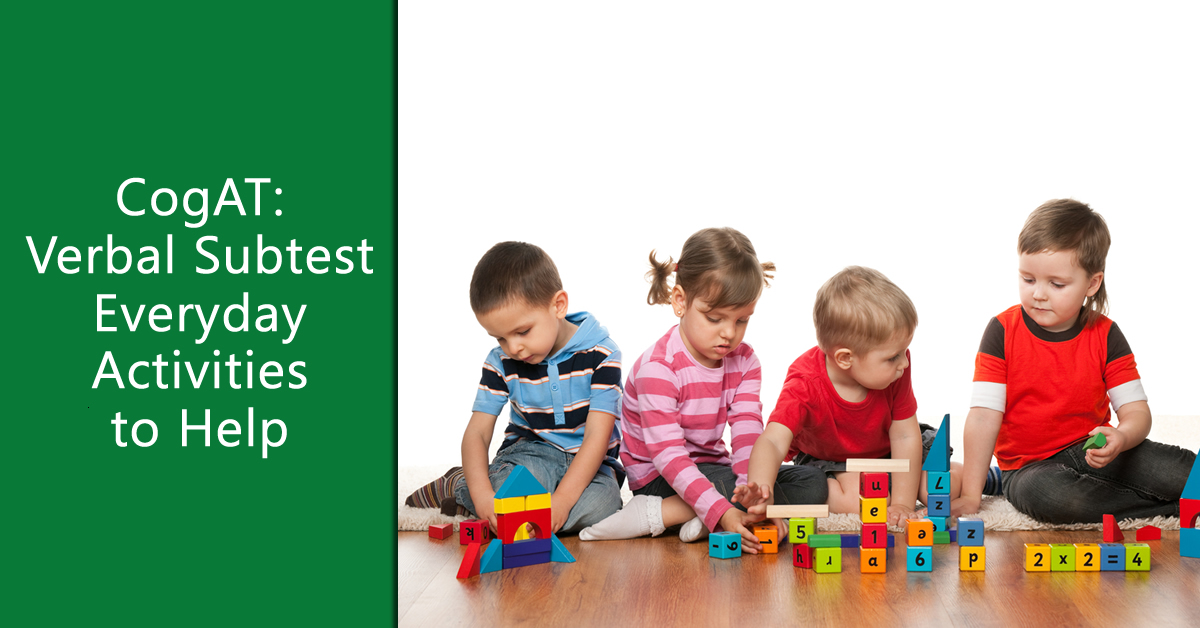› CogAT Practice: Everyday Activities to Help with the Verbal Subtest
CogAT Practice: Everyday Activities to Help with the Verbal Subtest
posted by Karen Quinn, The Testing Mom - September 27th, 2018
You can practice for the CogAT® by putting a little bit of extra effort into some everyday activities. This week and next week I will give a few activities that will help with the verbal portion of the test.

A Brief CogAT Overview
The CogAT Test, which is divided into three subtests, is designed to identify your child’s reasoning and problem solving abilities. By assessing these skills, educators can determine student eligibility for gifted and talented programs. The exam is customized to cater to your child’s grade level, as it extends from kindergarten through the 12th grade. Today I want to draw your attention to the verbal component of the CogAT. When it comes to studying for this exam, there are a fun and diverse array of everyday activities that can help your child to effectively prepare! Although your child will be “prepping” for the exam, he or she may not even be aware due to the creative and engaging nature of these activities. All of these methods that I will soon discuss can be completed by the student independently as well as with the entire family!
For a more complete overview of the test, please visit our CogAT Overview Page
What’s on the Verbal CogAT Practice Subtest Anyway?
Picture Analogies — Students are presented with a 2×2 matrix with three pictures with 1 empty cell. The question assesses your child’s ability to determine the relation between the 2 pictures located in the top two cells. Students are then advised to direct their attention to the picture in the bottom row. From there, they examine their answer choices in order to satisfy the relationship with the bottom row visual. The pictures on the bottom should have a parallel relationship to the pictures on top.
Sentence Completion — An educational facilitator presents students with an incomplete sentence or question. Based on the available options, students develop the necessary skills to select the picture that correctly completes the sentence or answers the question.
Picture Classification ‐ This section assesses your child’s ability to discover distinct similarities between a series of presented visuals. The objective is to select the one picture on the bottom that is in someway related to the visuals on top.
Everyday Activities that Help Your Child With the CogAT
CogAT Practice With Word Association Games
Word association games, such as “Apples to Apples,” are a fun and amusing game way that to allows your child to make comparisons, or find links, between different ideas. The player has the opportunity to strategize and detect common or abstract relationships between the topics that they are presented with. As a result, the child has the potential to come away with a better understanding of how to analogize. This is especially important on the CogAT since the student must often identify parallel relationships between sets of objects. The premise of the game is to choose seven red cards from the deck which all contain a noun. The player then must reference a green card in the middle which contains an adjective. The player then goes on to choose the red card in their deck that most closely describes the green card. With practice and consistency, the student should begin to discover even more nuanced links between the nouns and adjectives. “Apples to Apples” is a fantastic game to play with your child. You can also encourage them to get their friends involved in the fun!
CogAT Practice Through Reading
Reinforce vocabulary and word usage through reading! Books are invaluable when it comes to reinforcing listening skills, word fluency, and reading comprehension. Books are tools that encourage the child to ask questions about tricky or foreign words and concepts that they run into. Even if the student gets lost in the depths of the plot, they are gaining exposure to new and exciting vocabulary, ideas, and grammatical structures. If you are reading with your child, occasionally question them on the meaning of a word. Such questions may help to keep them engaged, alert, and thinking about the details of the story. In the case of an older student, talk to your child about documenting vocabulary that they are unsure of or want to know more about. Referencing a thesauruses or dictionary are not only excellent methods of looking words up, but encourages a form of self-advocacy through learning.
As you can see, there’s a lot to talk about when it comes to CogAT practice through everyday activities. These are only two things you can do to help practice for the verbal portion. I’ll be back next week with a few more activities you can do to help prepare for the verbal subtest of the CogAT! For now, you can view more of our CogAT resources below:
More CogAT Resources
CogAT Test
Best Methods for CogAT Test Prep
Sample CogAT Practice Questions
How is the CogAT Test Scored
CogAT Faq for Test Success
Everyday Activities for the Quantitative Section
More Everyday Activities for the Quantitative Section



Tell us about your experiences
One Response
hannanON27@gmail.com
Just signed up for the free questions lol. I have the test tommorow for Signet (gifted and talented.) Yeah, I’m 12, and have a 140 on the NNAT3. Wish me luck tommorow. I hate cogat.